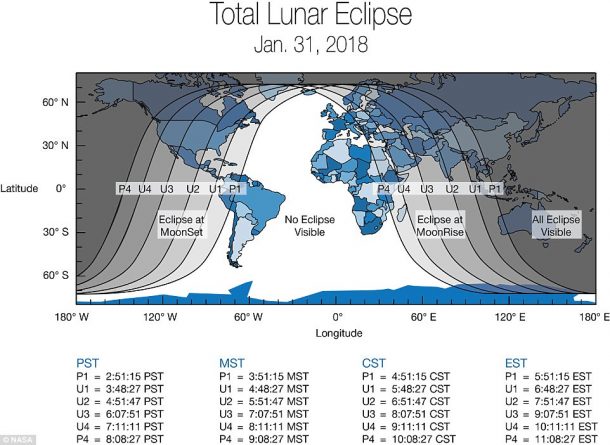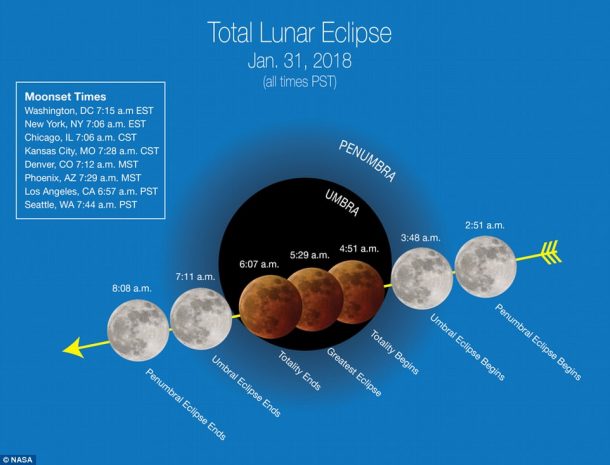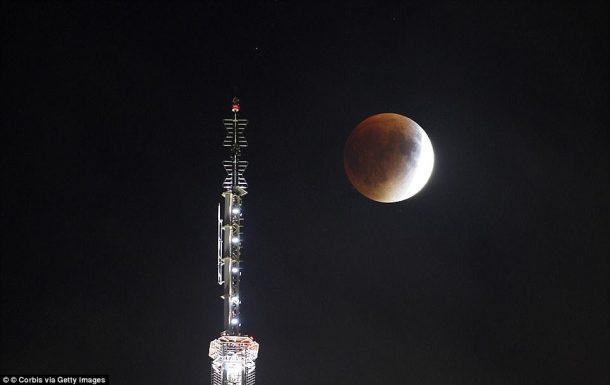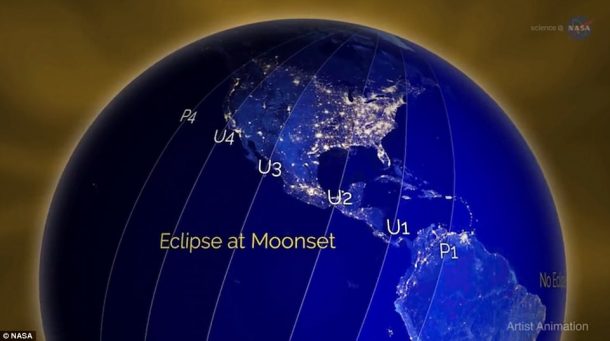Celestial events happen all year round but every now and then there comes an event that you don’t get to see every day and today is one of those days. You get to see the rare super blue blood moon that hasn’t been seen by much of the world in 150 years.
The super blue blood moon is the result of a blue moon, which is the second full moon in a calendar month, occurring at the same time as a supermoon, when the moon is 14% brighter than usual. This also combines with a blood moon, a moment during the lunar eclipse when the moon is in the Earth’s shadow and takes on a reddish hue.

The last blue moon total lunar eclipse was seen in 1982 in the Eastern Hemisphere but this will the first blue moon total eclipse since 1866 for the Western Hemisphere. The alignment of the Sun, Earth, and the moon will last one hour and 16 minutes. It will be visible before dawn on January 31st across North America, Alaska, Hawaii, and Canada.
For people living in the Middle East, Asia, Australia, New Zealand, and eastern Russia, the super blue blood moon will be visible during the moonrise in the evening. The experts say that the best viewing will be from the west. In the UK, the moonrise will begin around 4:55 pm GMT but the lunar eclipse will not begin until halfway through the night. The partial eclipse is expected to begin around 11:48 am GMT before reaching the peak at 1:29 pm GMT.

“Set your alarm early and go out and take a look”, said Gordon Johnston, program executive and lunar blogger at NASA Headquarters in Washington. “Weather permitting, the West Coast, Alaska and Hawaii will have a spectacular view of totality from start to finish.”
For the people in New York or Washington viewing the event, it will hardly be noticeable when the moon enters the outer part of Earth’s shadow at 10:51 GMT. The effect will become more prominent when the darker part of the Earth’s shadow covers it at 11:48 GMT but the moon will set a mere half hour later.

“So your best opportunity if you live in the East is to head outside about 11:45 GMT and get to a high place to watch the start of the eclipse—make sure you have a clear line of sight to the horizon in the west-northwest, opposite from where the sun will rise,” said Dr. Johnston.
Dr. Johnston is not the only person to have a say about it. “It’s an astronomical trifecta,” said Kelly Beatty, a senior editor at Sky and Telescope magazine.

“That red light you see is sunlight that has skimmed and bent through Earth’s atmosphere and continued on through space to the moon,” said Alan MacRobert of Sky and Telescope magazine. “In other words, it’s from all the sunrises and sunsets that ring the world at the moment.”
“Most of the time the full moon sits above or below Earth’s shadow and the moon remains flooded with sunlight,” explains Dr Tanya Hill, an Honorary Fellow of the University of Melbourne, writing for The Conversation. “But twice a year, the three bodies fall into line so that Earth casts its shadow on the moon.”

The Earth’s shadow is not black as some would expect but has a reddish hue. This is what gave rise to the name blood moon. The sunlight does manage to reach the moon but it does so after passing through the Earth’s atmosphere. This is what makes the sky redder. The lunar eclipse is safe to view from the naked eye without protective eyewear, unlike a solar eclipse.
“We’ve had a lot of supermoons and we’ve had lunar eclipses, but it’s rare that it also happens to be a blue moon,” said Jason Aufdenberg, associate professor of physics and astronomy at Embry-Riddle Aeronautical University’s campus in Daytona Beach, Florida. “All three of these cycles lining up is what makes this unusual. It’s just a wonder to behold.”
“The whole character of the moon changes when we observe with a thermal camera during an eclipse,” said Paul Hayne of the Laboratory for Atmospheric and Space Physics at the University of Colorado Boulder. “In the dark, many familiar craters and other features can’t be seen, and the normally nondescript areas around some craters start to ‘glow’ because the rocks there are still warm.”
“During a lunar eclipse, the temperature swing is so dramatic that it’s as if the surface of the moon goes from being in an oven to being in a freezer in just a few hours,” said Noah Petro, deputy project scientist for NASA’s Lunar Reconnaissance Orbiter, or LRO, at Goddard Space Flight Center in Greenbelt, Maryland.
The scientists will be observing it very carefully as studying the moon during eclipses give a lot of information about the evolution of the moon and give a good idea about the landing sites for future missions. “These studies will help us tell the story of how impacts large and small are changing the surface of the moon over geological time,” said Dr Petro.
If you are unable to watch the eclipse due to some reason, don’t worry. The whole event will be streamed live and the video will go live on 11:30 GMT:


